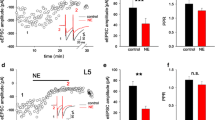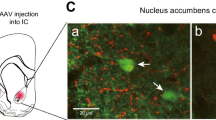Summary
The principal aim of this study was to characterize the transmitter mechanisms mediating fast postsynaptic potentials in identified neurons of the rat nucleus accumbens. Using the biocytin-avidin labeling technique, impaled neurons were identified as medium spiny neurons. The basic membrane characteristics of these neurons were determined. Local electrical stimulation or stimulation of the corpus callosum elicited a depolarizing postsynaptic potential consisting of an EPSP often followed by an IPSP. The quisqualate/kainate receptor antagonist 6-cyano-7-nitroquinoxaline-2,3-dione (4 μM) abolished most of the depolarizing postsynaptic potential. The N-methyl-D-aspartate receptor antagonist D(-)-2-amino-5-phosphonopentanoic acid depressed a small part of the decay phase of the depolarizing postsynaptic potential. Paired-pulse facilitation of postsynaptic potentials was found using interstimulus-intervals between 10 and 150 ms. N-methyl-D-aspartate receptors were found to contribute only slightly to the facilitation of the decay phase of the depolarizing postsynaptic potential, but not to its rising phase. This contribution was particularly clear under conditions of reduced GABAA receptor mediated inhibition. The present study indicates that postsynaptic responses of medium spiny neurons in the nucleus accumbens to local stimulation or stimulation of neocortical afferents are primarily mediated by quisqualate/kainate receptors. The contribution of NMDA receptors is normally limited to a portion of the decay phase of these responses, but is enlarged in the absence of GABAergic inhibition and following paired-pulse stimulation.
Similar content being viewed by others
References
Ashford MLJ, Boden P, Ramsey RL, Usherwood PNR (1989) Enhancement of desensitization of quisqualate-type glutamate receptor by the dissociative anaesthetic ketamine. J Exp Biol 141:73–86
Boeijinga PH, Pennartz CMA, Lopes da Silva FH (1990) Paired pulse facilitation in the nucleus accumbens following stimulation of subicular inputs in the rat. Neuroscience 35:301–311
Chang HT, Kitai ST (1985) Projection neurons of the nucleus accumbens: an intracellular labeling study. Brain Res 347:112–116
Chang HT, Kitai ST (1986) Intracellular recordings from rat nucleus accumbens in vitro. Brain Res 366:392–396
Cherubini E, Herrling PL, Lanfumey L, Stanzione P (1988) Excitatory amino acids in synaptic excitation of rat striatal neurones in vitro. J Physiol 400:677–690
Christie MJ, Summers RJ, Stephenson JA, Cook CJ, Beart PM (1987) Excitatory amino acid projections to the nucleus accumbens septi in the rat: a retrograde transport study utilizing D[3H]aspartate and [3H]GABA. Neuroscience 22:425–439
Cordingley GE, Weight FF (1986) Non-cholinergic synaptic excitation in neostriatum: pharmacological evidence for mediation by a glutamate-like transmitter. Br J Pharmacol 88:847–856
Crunelli V, Forda S, Kelly JS (1985) Excitatory amino acids in the hippocampus: synaptic physiology and pharmacology. Trends Neurosci 8:26–30
D'Angelo E, Rossi P, Garthwaite J (1990) Dual-component NMDA receptor currents at a single central synapse. Nature 346:467–470
Dingledine R, Hynes MA, King GL (1986) Involvement of N-methyl-D-asparate receptors in epileptiform bursting in the rat hippocampal slice. J Physiol 380:175–189
Duchen MR, Burton NR, Biscoe TJ (1985) An intracellular study of the interactions of N-methyl-DL-aspartate with ketamine in the mouse hippocampal slice. Brain Res 342:149–153
Fibiger HC, Phillips AG (1988) Mesocorticolimbic dopamine systems and reward. Ann NY Acad Sci 537:206–215
Forsythe ID, Westbrook GL (1988) Slow excitatory postsynaptic currents mediated by N-methyl-D-asparate receptors on cultured mouse central neurones. J Physiol 396:515–533
Fuller TA, Russchen FT, Price JL (1987) Sources of presumptive glutamergic/aspartergic afferents to the rat ventral striatopallidal region. J Comp Neurol 258:317–338
Greenamyre JT, Young AB (1989) Synaptic localization of striatal NMDA, quisqualate and kainate receptors. Neurosci Lett 101:133–137
Harris EW, Ganong AH, Cotman CW (1984) Long-term potentiation in the hippocampus involves activation of N-methyl-D-aspartate receptors. Brain Res 323:132–137
Harris KM, Miller RJ (1989) CNQX (6-cyano-7-nitroquinoxaline-2,3-dione) antagonizes NMDA-evoked [3H]GABA release from cultured cortical neurons via an inhibitory action at the strychnine-insensitive glycine site. Brain Res 489:185–189
Heimer L, Wilson RD (1975) The subcortical projection of the hippocampus, the pyriform cortex and the neocortex. In: Santini M (ed) Perspectives in neurobiology. Golgi centennial symposium. Raven Press, New York, pp 177–193
Heimer L, Alheid GF, Zaborszky L (1985) Basal Ganglia. In: Paxinos A (ed) The rat nervous system, Vol 1. Academic Press, Sydney, pp 37–86
Herron CE, Lester RAJ, Coan EJ, Collingridge GL (1986) Frequency-dependent involvement of NMDA receptors in the hippocampus: a novel synaptic mechanism. Nature 322:265–267
Honoré T, Davies SN, Drejer J, Fletcher EJ, Jacobsen P, Lodge D, Nielsen FE (1988) Quinoxalinediones: potent competitive non-NMDA glutamate receptor antagonists. Science 241:701–703
Horikawa K, Armstrong WE (1988) A versatile means of intracellular labeling: injection of biocytin and its detection with avidin conjugates. J Neurosci Meth 25:1–11
Jones RSG (1987) Complex synaptic responses of entorhinal cortical cells in the rat to subicular stimulation in vitro: demonstration of an NMDA receptor-mediated component. Neurosci Lett 81:209–214
Kawaguchi Y, Wilson CJ, Emson PC (1989) Intracellular recording of identified neostriatal patch and matrix spiny cells in a slice preparation preserving cortical inputs. J Neurophysiol 62:1052–1068
Kita H, Kita T, Kitai ST (1985) Active membrane properties of rat neostriatal neurons in an in vitro slice preparation. Exp Brain Res 60:54–62
Kita T, Kita H, Kitai ST (1984) Passive electrical membrane properties of rat neostriatal neurons in an in vitro slice preparation. Brain Res 300:129–139
Koob GF, Bloom FE (1988) Cellular and molecular mechanisms of drug dependence. Science 242:715–723
Lemon R, Prochazka A (1984) Methods for neuronal recording in conscious animals. Wiley, New York
Melchers BPC, Pennartz CMA, Wadman WJ, Lopes da Silva FH (1988) Quantitative correlation between tetanus-induced decreases in extracellular calcium and LTP. Brain Res 454:1–10
Mogenson GJ, Jones DL, Yim CY (1980) From motivation to action: functional interface between the limbic system and the motor system. Progr Neurobiol 14:69–97
Muller D, Lynch G (1988) Long-term potentiation differentially affects two components of synaptic responses in hippocampus. Proc Natl Acad Sci USA 85:9346–9350
Nakanishi H, Kita H, Kitai ST (1988) An N-methyl-D-aspartate receptor mediated excitatory postsynaptic potential evoked in subthalamic neurons in an vitro slice preparation of the rat. Neurosci Lett 95:130–136
Nauta WJH, Smith GP, Faull RLM, Domesick VB (1978) Efferent connections and nigral afferents of the nucleus accumbens septi in the rat. Neuroscience 3:385–401
Nowak L, Bregestovski P, Ascher P, Herbet A, Prochiantz A (1984) Magnesium gates glutamate-activated channels in mouse central neurones. Nature 307:462–465
Paxinos G, Watson C (1986) The rat brain in stereotaxic coordinates. Academic Press, New York
Pennartz CMA, Boeijinga PH, Lopes da Silva FH (1990) Locally evoked potentials in slices of the rat nucleus accumbens: NMDA and non-NMDA receptor mediated components and modulation by GABA. Brain Res 529:30–41
Rothman SM, Thurston JH, Hauhart RE, Clark GD, Solomon JS (1987) Ketamine protects hippocampal neurons from anoxia in vitro. Neuroscience 21:673–678
Scheel-Krüger J, Willner P (1991) The mesolimbic system: principles of operation. In: Willner P, Scheel-Krüger J (eds) The mesolimbic dopamine system: from motivation to action. Wiley, New York (in press)
Seeman P (1987) Dopamine receptors and the dopamine hypothesis of schizophrenia. Synapse 1:133–152
Smith AD, Bolam JP (1990) The neural network of the basal ganglia as revealed by the study of synaptic connections of identified neurons. Trends Neurosci 13:259–265
Swerdlow NR, Koob GF (1987) Dopamine, schizophrenia, mania and depression: toward a unified hypothesis of cortico-striato-pallido-thalamic function. Behav Brain Sci 10:197–245
Thomson AM (1989) Glycine modulation of the NMDA receptor/channel complex. Trends Neurosci 12:249–253
Thomson AM, West D, Lodge D (1985) An N-methylaspartate receptor-mediated synapse in rat cerebral cortex: a site of action of ketamine? Nature 313:479–481
Uchimura N, Cherubini E, North RA (1989a) Inward rectification in rat nucleus accumbens neurons. J Neurophysiol 62:1280–1286
Uchimura N, Higashi H, Nishi S (1989b) Membrane properties and synaptic responses of the guinea pig nucleus accumbens neurons in vitro. J Neurophysiol 61:769–779
Walaas I, Fonnum F (1980) Biochemical evidence for glutamate as a transmitter in hippocampal efferents to the basal forebrain and hypothalamus in the rat brain. Neuroscience 5:1691–1698
Walsh JP, Hull CD, Levine MS, Buchwald NA (1989) Kynurenic acid antagonizes the excitatory postsynaptic potential elicited in neostriatal neurons in the in vitro slice of the rat. Brain Res 480:290–293
Watkins JC, Olverman HJ (1987) Agonists and antagonists for excitatory amino acid receptors. Trends Neurosci 10:265–272
Yamada KA, Dubinsky JM, Rothman SM (1989) Quantitative physiological characterization of a quinoxalinedione non-NMDA receptor antagonist. J Neurosci 9:3230–3236
Zucker RS (1989) Short-term plasticity. Ann Rev Neurosci 12:13–31
Author information
Authors and Affiliations
Rights and permissions
About this article
Cite this article
Pennartz, C.M.A., Boeijinga, P.H., Kitai, S.T. et al. Contribution of NMDA receptors to postsynaptic potentials and paired-pulse facilitation in identified neurons of the rat nucleus accumbens in vitro. Exp Brain Res 86, 190–198 (1991). https://doi.org/10.1007/BF00231053
Received:
Accepted:
Issue Date:
DOI: https://doi.org/10.1007/BF00231053




